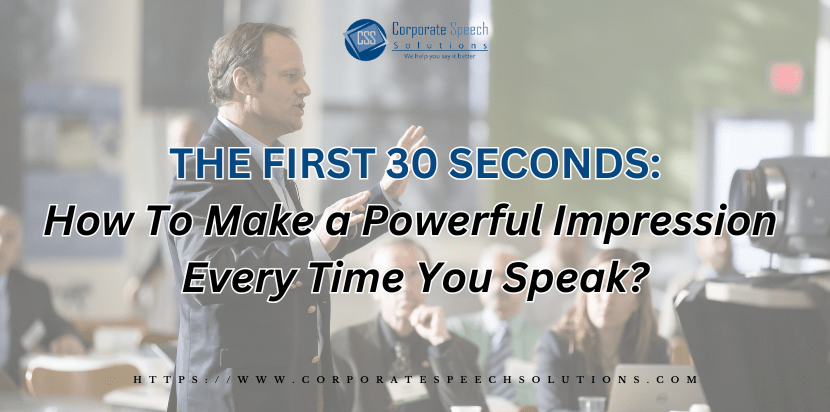Whether you’re leading a meeting, pitching to stakeholders, or giving a formal presentation, the first 30 seconds can make or break your impact.
In this blog, we’ll walk through practical strategies to help you make the most of that critical opening moment.
Why the First 30 Seconds Matter
Research shows that audiences begin forming judgments within moments. They’re listening for confidence, credibility, and relevance. That means your opening must be clear, engaging, and purposeful.
In those first few seconds, you have the opportunity to:
- Establish your presence
- Signal the value of what you’re about to say
- Capture attention and curiosity
1. Start with Purpose, Not Panic
The first few seconds often feel like the most nerve-wracking. Instead of rushing into your content, pause and take a breath. Center yourself and begin with purpose. Your audience can sense hesitation, so stepping into your speaking moment with calm confidence sets the tone.
Tip: Practice your opening line so it feels natural. Consider writing it down and rehearsing it aloud until it becomes second nature.
2. Grab Attention Immediately
One of my favorite tips is to avoid generic openers like “Thanks for being here.”
You may recall my use of A.I.D.E for an elevator speech- if not, we can revisit that later- however, the message is the same. Grab attention first (the “A” in A.I.D.E).
The goal is to hook your audience with something memorable:
- A compelling statistic: “Did you know 75% of professionals say they struggle to speak with confidence in meetings?”
- A thought-provoking question: “What makes one voice more credible than another?”
- A bold statement: “The way you speak is more powerful than what you say.”
These types of openings create curiosity and signal that your message is worth their attention.
3. Clarify Your Message Early
In your first 30 seconds, let the audience know what they can expect. A simple, confident statement like: “Today I’m going to show you how to communicate with clarity and impact—especially when the pressure is on,” provides direction and reinforces your credibility.
This is particularly effective in business settings where time is limited and people want to know what value they’ll gain.
4. Use Your Voice as a Tool
Your vocal delivery carries more weight than many realize. Research says that “How we say something matters twice as much as what we are actually saying!!”
In the first 30 seconds:
- Speak clearly and at a steady pace.
- Use strategic pauses for impact and emphasis.
- Avoid filler words (“um,” “like,” “you know”). Keep our barometer in mind and use no greater than two filler words in two minutes. Project your voice with energy and intention.
Your voice should convey authority, warmth, and engagement. Practice aloud to develop vocal variety and remove habits that weaken your message.
5. Make Eye Contact and Connect
Even in virtual meetings, your eyes matter. Looking into the camera—or around the room in live settings—creates instant connection. In those opening moments, you want to appear grounded, confident, and approachable.
Watch others when they speak. When they look down at their notes or the floor, what message are they conveying?
If you’re nervous, remind yourself: it’s not about you. It’s about your message and the people you’re there to help.
6. Rehearse Your Opening Separately
Many speakers practice their whole talk but forget to focus on the opening. Because those first seconds are so crucial, they deserve individual attention.
- Record yourself to hear how you sound.
- Try different openings and pick the strongest.
- Practice until it feels natural and authentic.
The goal is to start strong and build momentum. I always say, practice the first few minutes of the opening ten times more than the presentation as a whole. Practice, practice and practice a bit more!
7. Add a Personal Touch
If appropriate, share a brief personal insight or experience that relates to your topic. This humanizes you and makes you more relatable. Just be sure it’s purposeful and supports your message.
For example: “I was an incredibly shy young adult. I couldn’t even raise my hand in class to ask a question. That changed when I learned how to control my voice and speak with confidence.
With practice, you too can gain control of your voice and your delivery and begin to deliver your message with power, purpose and impact.
Closing Thoughts: You Only Get One Opening
The first 30 seconds is your chance to establish credibility, connect with your audience, and build trust. With intention and practice, you can make those seconds count—every time.
As a communication coach, I’ve helped hundreds of professionals transform their presence by mastering this exact skill. Whether you’re pitching, presenting, or participating in a high-stakes meeting, how you begin sets the tone for everything that follows.
With the right techniques and strategic practice, you’ll be ready to respond to any situation with clarity, confidence, and impact. Ready to sharpen your skills? Let’s start the conversation.
Click here to schedule a call.
Copyright 2024, Jayne Latz works with organizations and individuals that want to develop clear, concise and confident communication to accelerate career success.
Email: jayne@corporatespeechsolutions.com | Phone: 917.841.2965


Comments are closed